Accretion Disks and Long Cycles in β Lyrae-Type Binaries
Abstract
1. Introduction
2. The - Relationship
3. Insights on Disks of Systems Showing Lyrae-Type Light Curves
4. Light Curve Models for Individual Systems
5. Conclusions
Funding
Institutional Review Board Statement
Informed Consent Statement
Acknowledgments
Conflicts of Interest
Abbreviations
| DPV | Double Periodic Variable |
| OGLE | Optical Gravitational Lensing Experiment |
References
- Wilson, R.E. The secondary component of Beta Lyrae. Astrophys. J. 1974, 189, 319–329. [Google Scholar] [CrossRef]
- Harmanec, P.; Morand, F.; Bonneau, D.; Jiang, Y.; Yang, S.; Guinan, E.F.; Hall, D.S.; Mourard, D.; Hadrava, P.; Bozic, H.; et al. Jet-like structures in β Lyrae. Results of optical interferometry, spectroscopy and photometry. Astron. Astrophys. 1996, 312, 879–896. [Google Scholar]
- Ak, H.; Chadima, P.; Harmanec, P.; Demircan, O.; Yang, S.; Koubský, P.; Škoda, P.; Šlechta, M.; Wolf, M.; Božić, H.; et al. New findings supporting the presence of a thick disc and bipolar jets in the β Lyrae system. Astron. Astrophys. 2007, 463, 233–241. [Google Scholar] [CrossRef]
- Zhao, M.; Gies, D.; Monnier, J.D.; Thureau, N.; Pedretti, E.; Baron, F.; Merand, A.; ten Brummelaar, T.; McAlister, H.; Ridgway, S.T.; et al. First Resolved Images of the Eclipsing and Interacting Binary β Lyrae. Astrophys. J. Lett. 2008, 684, L95. [Google Scholar] [CrossRef]
- Harmanec, P.; Scholz, G. Orbital elements of beta Lyrae after the first 100 years of investigation. Astron. Astrophys. 1993, 279, 131–147. [Google Scholar]
- Hubeny, I.; Plavec, M.J. Can A Disk Explain Beta Lyrae? Astron. J. 1991, 102, 1156. [Google Scholar] [CrossRef]
- Brož, M.; Mourard, D.; Budaj, J.; Harmanec, P.; Schmitt, H.; Tallon-Bosc, I.; Bonneau, D.; Božić, H.; Gies, D.; Šlechta, M. Optically thin circumstellar medium in the β Lyr A system. Astron. Astrophys. 2021, 645, A51. [Google Scholar] [CrossRef]
- Mennickent, R.E.; Djurašević, G. On the accretion disc and evolutionary stage of β Lyrae. Mon. Not. R. Astron. Soc. 2013, 432, 799–809. [Google Scholar] [CrossRef]
- Wilson, R.E. Close Binary Perspectives. Galaxies 2020, 8, 57. [Google Scholar] [CrossRef]
- Lorenzi, L. Mathematical analysis of some photometric peculiarities of AU Mon. Astron. Astrophys. 1980, 85, 342–349. [Google Scholar]
- Hill, G.; Harmanec, P.; Pavlovski, K.; Bozic, H.; Hadrava, P.; Koubsky, P.; Ziznovsky, J. Properties and nature of Be stars. 17. V360 Lac = HD 216200 is a B3e + F9IV: Binary. Astron. Astrophys. 1997, 324, 965–976. [Google Scholar]
- Koubsky, P.; Harmanec, P.; Bozic, H.; Rercy, J.R.; Ziznovsky, J.; Huang, L.; Richards, M.T.; Hadrava, P.; Simon, V. Spectroscopy and Photometry of the Interacting Binary CX Draconis - Evidence for Circumstellar Mater. Hvar Obs. Bull. 1998, 22, 17–36. [Google Scholar]
- Pilecki, B.; Szczygiel, D.M. 13 New Eclipsing Binaries with Additional Variability in the ASAS Catalogue. Inf. Bull. Var. Stars 2007, 5768, 1. [Google Scholar]
- Mennickent, R.E.; Djurašević, G.; Vince, I.; Garcés, J.; Hadrava, P.; Cabezas, M.; Petrović, J.; Jurkovic, M.I.; Korčáková, D.; Markov, H. New insights on the massive interacting binary UU Cassiopeiae. Astron. Astrophys. 2020, 642, A211. [Google Scholar] [CrossRef]
- Guinan, E.F. Algol, Beta Lyrae, and W Serpentis: Some new results for three well studied eclipsing binaries. Space Sci. Rev. 1989, 50, 35–49. [Google Scholar] [CrossRef]
- Wilson, R.E.; van Hamme, W. Periodicities and regulatory mechanisms in beta Lyrae. Mon. Not. R. Astron. Soc. 1999, 303, 736–754. [Google Scholar] [CrossRef][Green Version]
- van Rensbergen, W.; De Greve, J.P.; De Loore, C.; Mennekens, N. Spin-up and hot spots can drive mass out of a binary. Astron. Astrophys. 2008, 487, 1129–1138. [Google Scholar] [CrossRef]
- Wilson, R.E. Self-gravitating Semi-transparent Circumstellar Disks: An Analytic Model. Astrophys. J. 2018, 869, 19. [Google Scholar] [CrossRef]
- Petrovic, J.; Langer, N.; van der Hucht, K.A. Constraining the mass transfer in massive binaries through progenitor evolution models of Wolf-Rayet+O binaries. Astron. Astrophys. 2005, 435, 1013–1030. [Google Scholar] [CrossRef]
- de Mink, S.E.; Pols, O.R.; Langer, N.; Izzard, R.G. Massive binaries as the source of abundance anomalies in globular clusters. Astron. Astrophys. 2009, 507, L1–L4. [Google Scholar] [CrossRef]
- van Rensbergen, W.; de Greve, J.P. On the Modeling of Algol-Type Binaries. Galaxies 2021, 9, 19. [Google Scholar] [CrossRef]
- Deschamps, R.; Braun, K.; Jorissen, A.; Siess, L.; Baes, M.; Camps, P. Non-conservative evolution in Algols: Where is the matter? Astron. Astrophys. 2015, 577, A55. [Google Scholar] [CrossRef]
- Mennickent, R.E.; Pietrzyński, G.; Diaz, M.; Gieren, W. Double-periodic blue variables in the Magellanic Clouds. Astron. Astrophys. 2003, 399, L47–L50. [Google Scholar] [CrossRef]
- Mennickent, R.E.; Otero, S.; Kołaczkowski, Z. Interacting binaries W Serpentids and double periodic variables. Mon. Not. R. Astron. Soc. 2016, 455, 1728–1745. [Google Scholar] [CrossRef]
- Poleski, R.; Soszyński, I.; Udalski, A.; Szymański, M.K.; Kubiak, M.; Pietrzyński, G.; Wyrzykowski, Ł.; Ulaczyk, K. The Optical Gravitational Lensing Experiment. The OGLE-III Catalog of Variable Stars. X. Enigmatic Class of Double Periodic Variables in the Large Magellanic Cloud. Acta Astron. 2010, 60, 179–196. [Google Scholar]
- Pawlak, M.; Graczyk, D.; Soszyński, I.; Pietrukowicz, P.; Poleski, R.; Udalski, A.; Szymański, M.K.; Kubiak, M.; Pietrzyński, G.; Wyrzykowski, Ł.; et al. Eclipsing Binary Stars in the OGLE-III Fields of the Small Magellanic Cloud. Acta Astron. 2013, 63, 323–338. [Google Scholar]
- Garrido, H.E.; Mennickent, R.E.; Djurašević, G.; Kołaczkowski, Z.; Niemczura, E.; Mennekens, N. Physical parameters and evolutionary route for the Large Magellanic Cloud interacting binary OGLE 05155332-6925581. Mon. Not. R. Astron. Soc. 2013. [Google Scholar] [CrossRef]
- Mennickent, R.E. On the Evolutionary Stage of the Interacting Binary AU Mon. Publ. Astron. Soc. Pac. 2014, 126, 821. [Google Scholar] [CrossRef]
- Mennickent, R.E. Long Photometric Cycles in Hot Algols. Serbian Astron. J. 2017, 194, 1–21. [Google Scholar] [CrossRef]
- Mennickent, R.E.; Zharikov, S.; Cabezas, M.; Djurašević, G. Doppler tomography of the Double periodic variable HD 170582 at low and high stage. Mon. Not. R. Astron. Soc. 2016, 461, 1674–1683. [Google Scholar] [CrossRef][Green Version]
- Van Rensbergen, W.; De Greve, J.P. Accretion disks in Algols: Progenitors and evolution. Astron. Astrophys. 2016, 592, A151. [Google Scholar] [CrossRef][Green Version]
- Rosales, J.A. TYC 5353-1137-1: An enigmatic Doubly Periodic Variable of semiregular amplitude. Inf. Bull. Var. Stars 2018, 6248, 1. [Google Scholar] [CrossRef]
- Rosales, J.A.; Mennickent, R.E. New Double Periodic Variable stars in the ASAS-SN Catalog. Inf. Bull. Var. Stars 2019, 6268, 1. [Google Scholar] [CrossRef]
- Rojas García, G.; Mennickent, R.; Iwanek, P.; Gorrini, P.; Garcés, J.; Soszyński, I.; Astudillo-Defru, N. New Galactic β Lyrae-type Binaries Showing Superorbital Photometric Cycles. Astrophys. J. 2021, 922, 30. [Google Scholar] [CrossRef]
- Schleicher, D.R.G.; Mennickent, R.E. A dynamo mechanism as the potential origin of the long cycle in double periodic variables. Astron. Astrophys. 2017, 602, A109. [Google Scholar] [CrossRef]
- Applegate, J.H. A Mechanism for Orbital Period Modulation in Close Binaries. Astrophys. J. 1992, 385, 621. [Google Scholar] [CrossRef]
- San Martín-Pérez, R.I.; Schleicher, D.R.G.; Mennickent, R.E.; Rosales, J.A. Dynamo effect in the double periodic variable DQ Velorum. Bol. De La Asoc. Argent. De Astron. La Plata Argent. 2019, 61, 107–109. [Google Scholar]
- Piirola, V. A polarimetric study of U Cep. Part I. Astron. Astrophys. 1980, 90, 48–53. [Google Scholar]
- Doğan, S.; Nixon, C.; King, A.; Price, D.J. Tearing up a misaligned accretion disc with a binary companion. Mon. Not. R. Astron. Soc. 2015, 449, 1251–1258. [Google Scholar] [CrossRef]
- Larwood, J.D.; Nelson, R.P.; Papaloizou, J.C.B.; Terquem, C. The tidally induced warping, precession and truncation of accretion discs in binary systems: Three-dimensional simulations. Mon. Not. R. Astron. Soc. 1996, 282, 597–613. [Google Scholar] [CrossRef]
- Mennickent, R.E.; Kołaczkowski, Z.; Djurasevic, G.; Niemczura, E.; Diaz, M.; Curé, M.; Araya, I.; Peters, G.J. A cyclic bipolar wind in the interacting binary V 393 Scorpii. Mon. Not. R. Astron. Soc. 2012, 427, 607–624. [Google Scholar] [CrossRef]
- Lubow, S.H.; Shu, F.H. Gas dynamics of semidetached binaries. Astrophys. J. 1975, 198, 383–405. [Google Scholar] [CrossRef]
- Atwood-Stone, C.; Miller, B.P.; Richards, M.T.; Budaj, J.; Peters, G.J. Modeling the Accretion Structure of AU Mon. Astrophys. J. 2012, 760, 134. [Google Scholar] [CrossRef]
- Djurašević, G.; Latković, O.; Vince, I.; Cséki, A. Accretion disc in the eclipsing binary AU Mon. Mon. Not. R. Astron. Soc. 2010, 409, 329–336. [Google Scholar] [CrossRef]
- Mennickent, R.E.; Djurašević, G. Model for the long and orbital brightness variability of the β Lyrae type binary OGLE-BLG-ECL-157529. Astron. Astrophys. 2021, 653, A89. [Google Scholar] [CrossRef]
- Richards, M.T. Doppler tomography of Algols. Astron. Nachrichten 2004, 325, 229–232. [Google Scholar] [CrossRef]
- Mimica, P.; Pavlovski, K. Reconstruction of an Accretion Disk Image in AU Mon from CoRoT Photometry. Proc. Int. Astron. Union 2011, 7, 63–64. [Google Scholar] [CrossRef][Green Version]
- Kaigorodov, P.V.; Bisikalo, D.V.; Kurbatov, E.P. Interaction of the stream from L 1 with the outer edge of the accretion disk in a cataclysmic variable. Astron. Rep. 2017, 61, 639–645. [Google Scholar] [CrossRef]
- Dervişoǧlu, A.; Tout, C.A.; Ibanoǧlu, C. Spin angular momentum evolution of the long-period Algols. Mon. Not. R. Astron. Soc. 2010, 406, 1071–1083. [Google Scholar] [CrossRef]
- Mennickent, R.E.; Djurašević, G.; Cabezas, M.; Cséki, A.; Rosales, J.G.; Niemczura, E.; Araya, I.; Curé, M. Fundamental parameters of the close interacting binary HD 170582 and its luminous accretion disc. Mon. Not. R. Astron. Soc. 2015, 448, 1137–1152. [Google Scholar] [CrossRef]
- Rosales, J.A.; Mennickent, R.E.; Djurašević, G.; Schleicher, D.R.G.; Zharikov, S.; Araya, I.; Celedón, L.; Curé, M. Stellar and Accretion Disk Parameters of the Close Binary HD 50526. Astron. J. 2021, 162, 66. [Google Scholar] [CrossRef]
- Plavec, M.J. Circumstellar Emissions in ALGOLS and Serpentids (Invited Paper). In Nonisotropic and Variable Outflows from Stars; Drissen, L., Leitherer, C., Nota, A., Eds.; Astronomical Society of the Pacific Conference Series; Astronomical Society of the Pacific: San Francisco, CA, USA, 1992; Volume 22, p. 47. [Google Scholar]
- Peters, G.J.; Polidan, R.S. Eclipse mapping of the hot circumstellar plasma in Algol binaries. Astron. Nachrichten 2004, 325, 225–228. [Google Scholar] [CrossRef]
- Bisikalo, D.V.; Harmanec, P.; Boyarchuk, A.A.; Kuznetsov, O.A.; Hadrava, P. Circumstellar structures in the eclipsing binary beta Lyr A. Gasdynamical modelling confronted with observations. Astron. Astrophys. 2000, 353, 1009–1015. [Google Scholar]
- Szymanski, M.K. The Optical Gravitational Lensing Experiment. Internet Access to the OGLE Photometry Data Set: OGLE-II BVI maps and I-band data. Acta Astron. 2005, 55, 43–57. [Google Scholar]
- Udalski, A.; Szymański, M.K.; Szymański, G. OGLE-IV: Fourth Phase of the Optical Gravitational Lensing Experiment. Acta Astron. Astron. 2015, 65, 1–38. [Google Scholar]
- Garcés L, J.; Mennickent, R.E.; Djurašević, G.; Poleski, R.; Soszyński, I. Structural changes in the hot Algol OGLE-LMC-DPV-097 and its disc related to its long cycle. Mon. Not. R. Astron. Soc. 2018, 477, L11–L15. [Google Scholar] [CrossRef]
- Mennickent, R.E.; Cabezas, M.; Djurašević, G.; Rivinius, T.; Hadrava, P.; Poleski, R.; Soszyński, I.; Celedón, L.; Astudillo-Defru, N.; Raj, A.; et al. On the long-cycle variability of the Algol OGLE-LMC-DPV-065 and its stellar, orbital, and disc parameters. Mon. Not. R. Astron. Soc. 2019, 487, 4169–4180. [Google Scholar] [CrossRef]
- Terrell, D.; Wilson, R.E. Photometric Mass Ratios of Eclipsing Binary Stars. Astrophys. Space Sci. 2005, 296, 221–230. [Google Scholar] [CrossRef]
- Djurasevic, G. An Analysis of Active Close Binaries/CB/Based on Photometric Measurements. Astrophys. Space Sci. 1992, 197, 17–34. [Google Scholar] [CrossRef]
- Djurašević, G. An Analysis of Active Close Binaries/CB/Based on Photometric Measurements-Part Two—Active CB with Accretion Discs. Astrophys. Space Sci. 1992, 196, 267–282. [Google Scholar] [CrossRef]
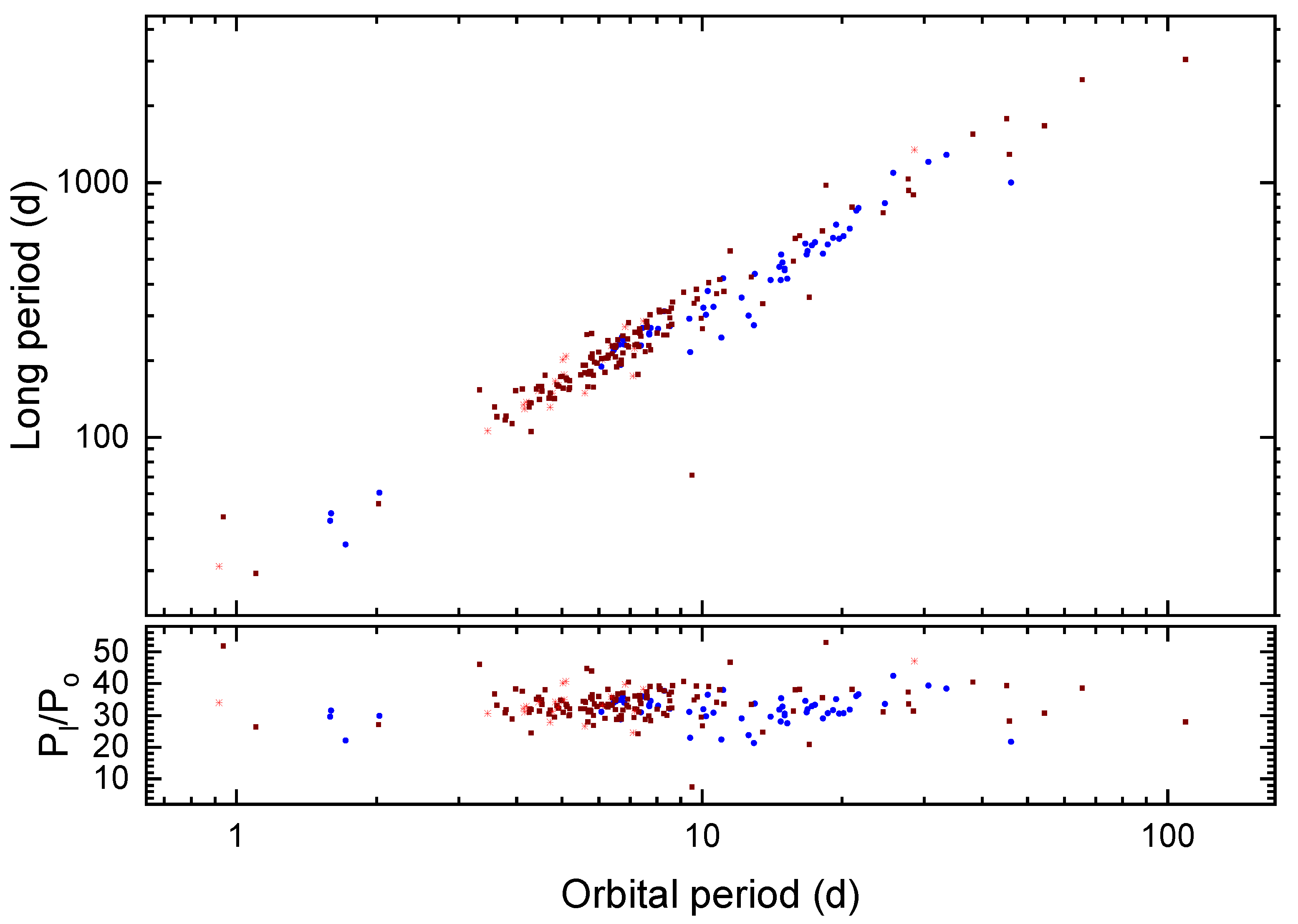

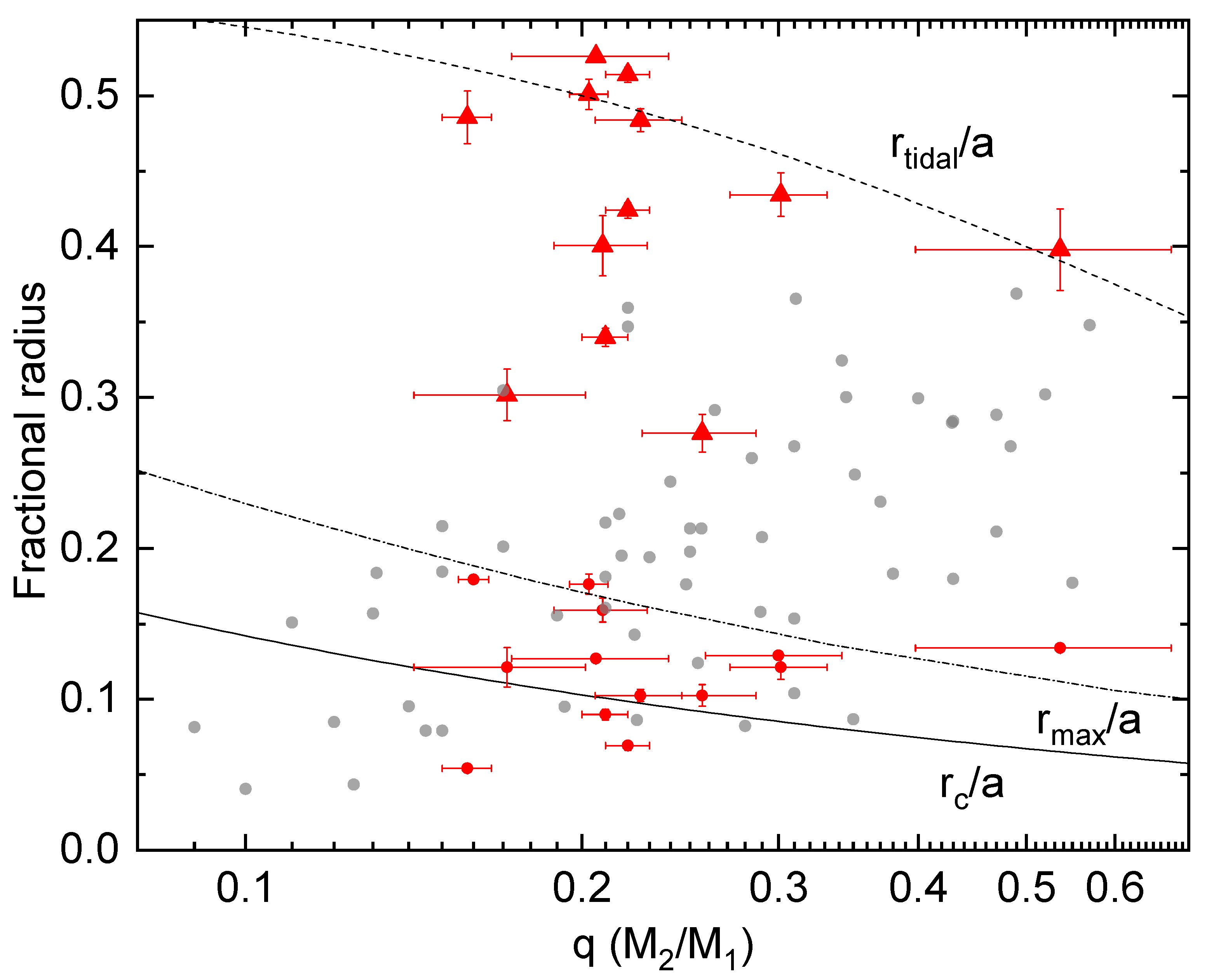

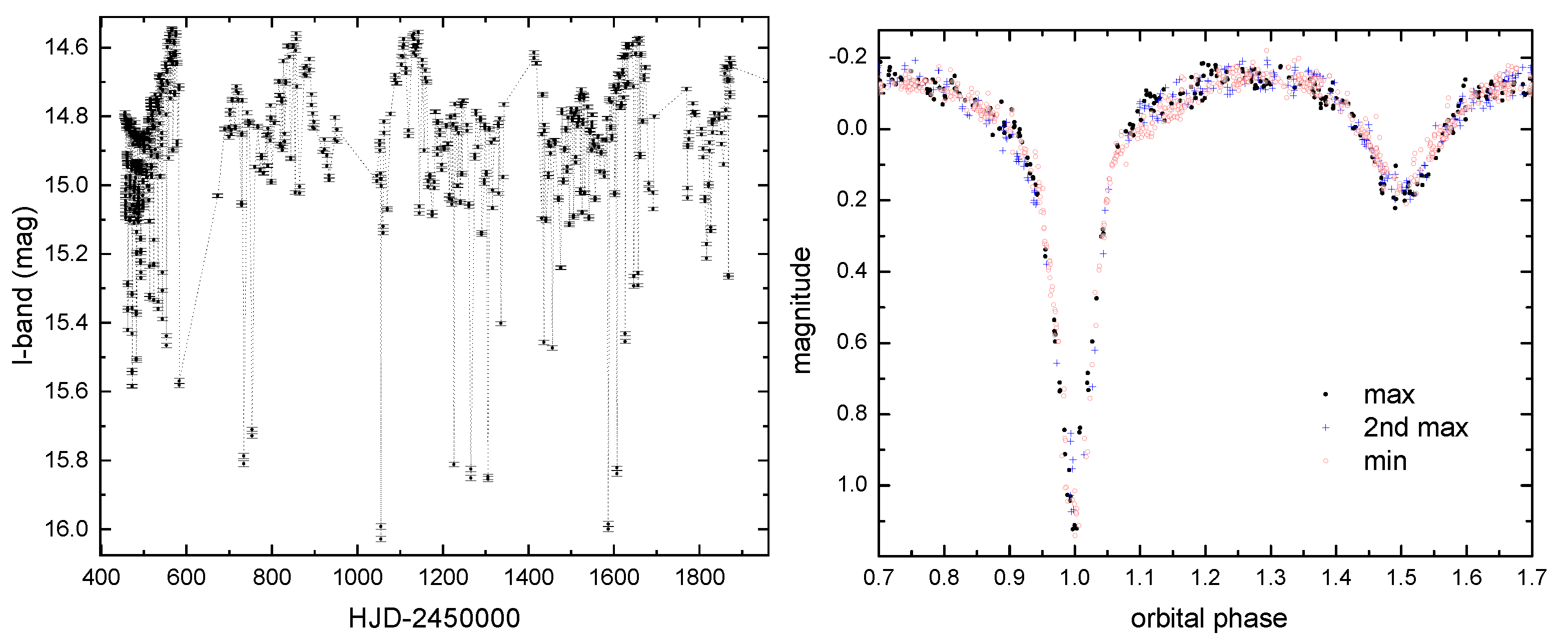
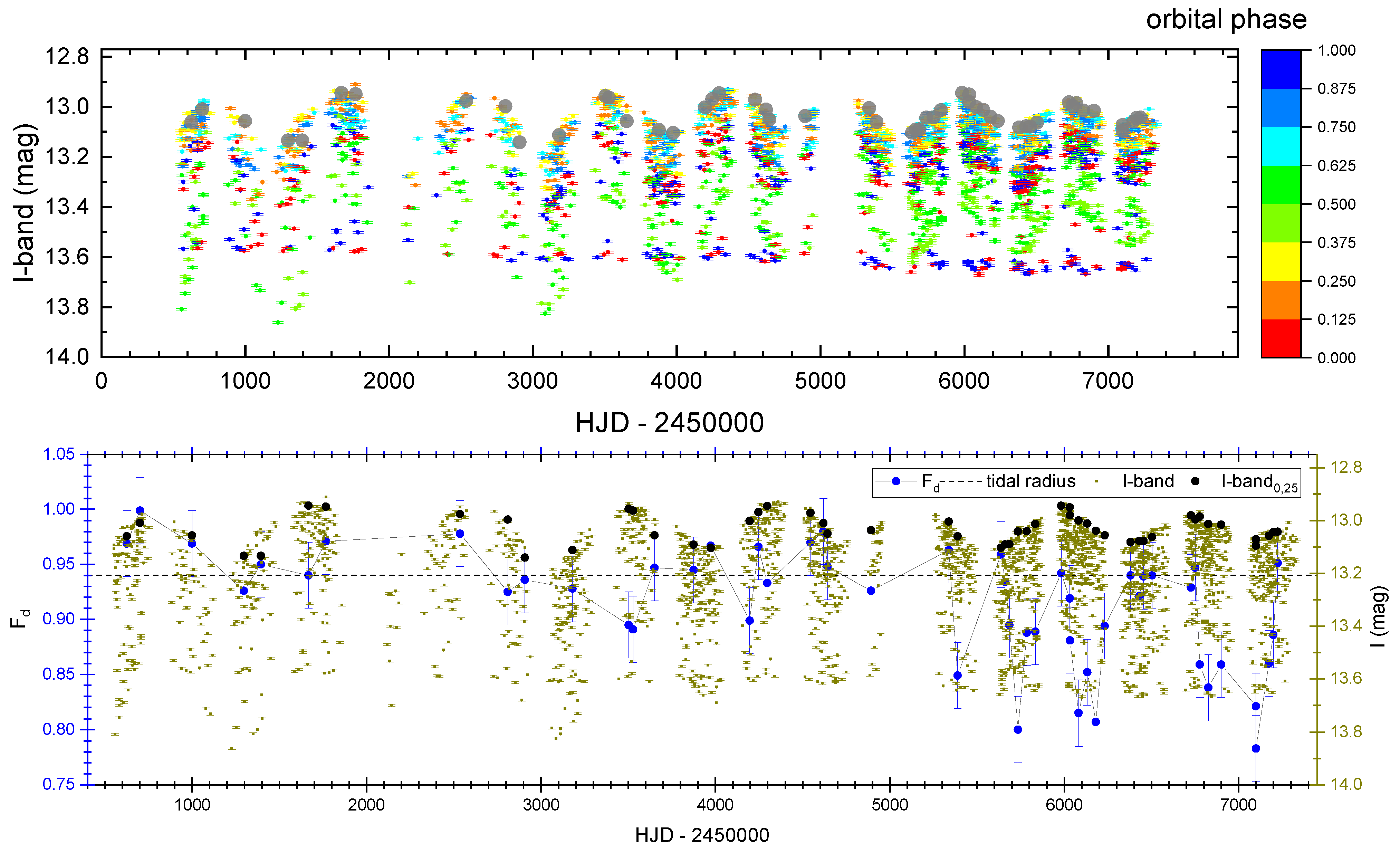
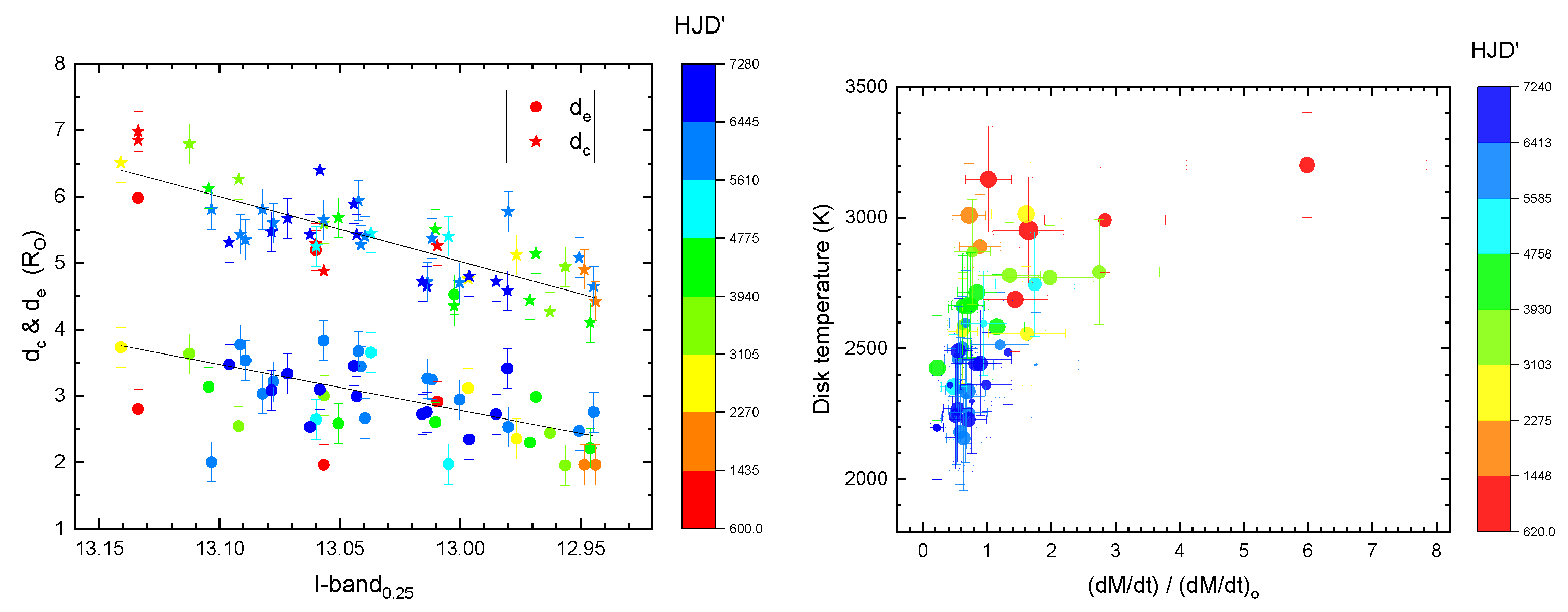
| System | P | P | M | M | T | T | i |
|---|---|---|---|---|---|---|---|
| (d) | (d) | (Msun) | (Msun) | (K) | (K) | () | |
| *OGLE-BLG-ECL-157529 | 24.80 | 900–800 | 4.83 | 1.06 | 14,000 | 4400 | 85.5 |
| Lyrae | 12.95 | 282.4 | 13.2 | 2.97 | 30,000 | 13,300 | 86.1 |
| OGLE-LMC-DPV-065 | 10.03 | 350–210 | 13.8 | 2.81 | 25,460 | 9825 | 86.7 |
| *OGLE-LMC-DPV-097 | 7.75 | 306 | 5.51 | 1.10 | 14,000 | 4030–6870 | 74 |
Publisher’s Note: MDPI stays neutral with regard to jurisdictional claims in published maps and institutional affiliations. |
© 2022 by the author. Licensee MDPI, Basel, Switzerland. This article is an open access article distributed under the terms and conditions of the Creative Commons Attribution (CC BY) license (https://creativecommons.org/licenses/by/4.0/).
Share and Cite
Mennickent, R.E. Accretion Disks and Long Cycles in β Lyrae-Type Binaries. Galaxies 2022, 10, 15. https://doi.org/10.3390/galaxies10010015
Mennickent RE. Accretion Disks and Long Cycles in β Lyrae-Type Binaries. Galaxies. 2022; 10(1):15. https://doi.org/10.3390/galaxies10010015
Chicago/Turabian StyleMennickent, R. E. 2022. "Accretion Disks and Long Cycles in β Lyrae-Type Binaries" Galaxies 10, no. 1: 15. https://doi.org/10.3390/galaxies10010015
APA StyleMennickent, R. E. (2022). Accretion Disks and Long Cycles in β Lyrae-Type Binaries. Galaxies, 10(1), 15. https://doi.org/10.3390/galaxies10010015






